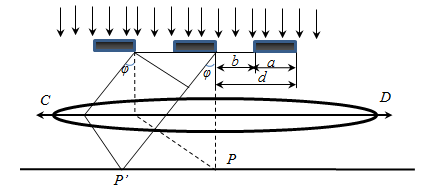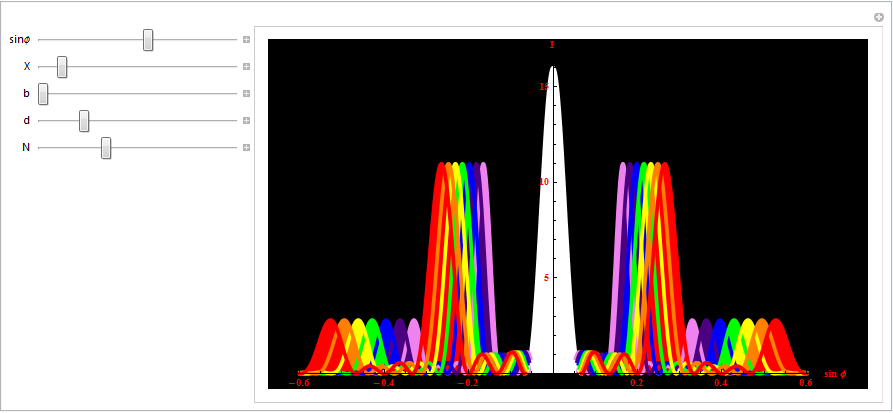main
To the list of lectures
|
§4 Fraunhofer diffraction on a single slit Fraunhofer diffraction (or diffraction plane light waves, or parallel-ray diffraction) was observed in the case where the light source and the observation point is infinitely removed from the constraints of diffraction.
We divide the wave surface at the site MN
gap on the Fresnel zone, having a form of bands parallel to the edge
of the M slots. The width of each band is selected to the path
difference from the edges of these zones is equal to λ/2, ie, in all on slit width go in
or
then in point P is observed diffraction minimum. Maximum condition: If an odd number of Fresnel zones
is observed diffraction maximum. When φ’=0, Δ = 0in the gap fits one Fresnel zone and, therefore, in point P the main (center) a maximum of zero order. The main part of the light energy is concentrated in the main maximum: m = 0:1:2:3 ...; I = 1: 0.047: 0.017: 0.0083 ... (m-high order; I-intensity). The narrowing gap leads to a broadening of the main peak and a decrease in its brightness (the same with the other peaks). With the broadening of the gap (b > λ) peaks will be brighter, but the diffraction bands are narrower, and the number of bands themselves - more. When b >> λ in the center of the source image is sharp, ie have the rectilinear propagation of light. When falling of white light is decomposed into its components. While violet light will deviate less blue - more, etc., red - maximum. The main maximum in this case will be white.
§5 The diffraction grating
b -width of the gap; а - the width of the opaque area; d = a + b -period or lattice constant .
The diffraction pattern on the lattice is defined as the mutual interference of the waves coming from all the cracks, ie a diffraction grating is multipath interference. Because slits are separated by the same distance, the differences of the rays coming from the two adjacent slots will be for the direction φ are identical across the entire grating .
In areas in which there is a minimum of one slit, and minimums will be in the case of N slots, ie the condition of the primary minimum of the diffraction grating is analogous to the condition for the minimum gap:
- the condition of the primary minimum. The maximum condition: the cases φ, which satisfy the maximum for the single slit can be either maxima or minima, as it all depends on the path difference between the beams. The condition of the main maxima:
These peaks are located symmetrically relative to the center (zero k = 0) maximum.
Between the main peak will be located (N - 1) additional minima. Additional minimum condition:
Thus, the diffraction pattern, at the diffraction on grating depends on N and the ratio d/b.
If the the diffraction grating light up a monochromatic white light, the image will be shown in Fig. If illuminated with white light, all peaks except center (k = 0) decompose in the range - a set of component colors, and purple lines are closer to the center and red on (because λv < λr then φr < φv).
|





